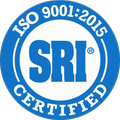Hafnium exhibits a marked tendency to gall and work harden. Therefore, higher than normal clearance angles on tools are needed to penetrate the previously work hardened surface and cut a clean course chip. Good results can be obtained with both cemented carbide and high speed tools. However, the cemented carbide usually provides a better finish and higher productivity. Hafnium machine’s to an excellent finish due to the hafnium properties, and the operation requires somewhat little horsepower compared with that of alloy steel. Fine chips should not be allowed to accumulate on or near the machining equipment because they can be easily ignited. The chips should be continually removed and stored, preferably under water in remote and isolated areas that are far removed from the production site.
Milling:
Both vertical face and horizontal slab milling give good results. Wherever possible hafnium should be climb milled to penetrate the work at the maximum approach angle and depth of cut while emerging through the work hardened area. The faces and edges of milling cutters should be kpt very sharp. A set of herringbone cutters will permit positive axial rake angles to be effective at both sides of a recess. Optimum surface finish and tool life are obtained when the tool is ground with a positive 12° to 15° radial rake along with cutting corner. A high spiral flute should also be used. The work should be flooded or sprayed with a coolant to completely wash away all chips from the tool. The penetration can range from .005 to .010 inch per tooth at 150 to 250 SFPM. The work absorbs about 10 percent of the cutting energy with sharp cutters. Hafnium requires only about 75 percenct of the horsepower required for SAE 1020 CR steel.
Grinding:
The grinding methods used for hafnium involve standard grinding machine equipment. The grinding characteristics of hafnium is similar to those of other metals, and both wheel and belt grinding can be used. The use of straight grinding oil or oil coolant produces a better finish and higher yields; these substances also prevent ignition of dry grinding swarf. Conventional grinding speeds and feeds can be used. Both silicon carbide and aluminum oxide can be used as abrasives, but silicon carbide generally gives better results.
Wheel Grinding:
Hafnium produces a white stream of sparks. Conventional speeds and feeds are satisfactory and silicon carbide generally gives better results than aluminum oxide. At light in feeds and slow wheel speeds, higher grinding ratios are produced. At heavier in feeds and slow wheel speeds, lower grinding ratios are produced. The finishes produced are in relation to the grinding ratios. Higher grinding ratios, which mean less wheel breakdown, produce finer finishes. The effect of grinding fluid on hafnium is the same as for other metals. Straight grinding oils produce higher grinding ratios than water miscible fluids at all in feeds.
Belt Grinding:
Belt Speed and contact wheel selection are two primary considerations when grinding hafnium. Recommended belt speeds are 2,000 to 3,000 SFPM at low grinding pressures with 50 grit and coarser material, and 2,500 to 3,500 SFPM with 60 grit and finer belts with similar working pressure. At high grinding pressures, 2,500 to 3,500 SFPM are recommeded with 50 grit and coarser and 3,000 to 4,000 SFPM with 60 grit and finer.
Contact wheels should be relatively hard and aggressive. Soluble oil coolants alone, or mixed with water and applied in a flood are recommended. Resin abrasive cloth may be used with oil and rubber contact wheels on general polishing operations. Resin Industrial Cloth Type 3 or Type 6 are recommended for use with oil in grinding operations where high grinding pressures are used. Similarly, waterproof cloth silicon carbide for light work and aluminum oxide for heavy work may be effectively employed with soluble oil and water coolants.
Welding:
Hafnium has better weldability than some more common construction materials, provided that the proper procedure is followed. Proper shielding from air with inert gasses such as argon or helium is very important when welding these metals. Because of the reactivity of hafnium to most gases at welding temeratures, welding without proper shielding will allow the absorption of oxygen, hydrogen and nitrogen from the atmosphere and thus embrittle the weld. Hafnium is most commonly welded by the gas tungsten arc welding (GTAW) technique. Other welding methods used for these material include gas metal arc welding (GMAW), plasma arc welding, electron beam welding and resistance welding.
Hafnium metal has low coefficients of thermal expansion and thus experience little distortion during welding. Inclusions are not usually a problem in the welds because these metals have a high solubility for their own oxides, and because no fluxes are used in welding, flux entrapment is eliminated. Hafnium has a low modulus of elasticity; therefore, residual stresses are low in a finished weld. However, stress relief of these welds has been found to be beneficial. A stress-relief temperature of 550° (1020°F) should be used for hafnium.
Hanfium is subject to severe embrittlement by relatively minute amounts of impurities, especially nitrogen, oxygen, carbon, and hydrogen. They have a high affinity for these elements at the welding temperature. Because of this high affinity for gaseous elements, hafnium must either be welded using arc welding processes with inert shielding gases, such as argon or helium, or be welded in a vacuum.
The most common techniques used for welding hafnium is the inert gas GTAW and GMAW methods. This equipment can be set up and used in the manual or automatic welding modes. Alternating current can be used for gas tungsten arc welding. Straight polarity is preferred for welding with a consumable electode filler wire because this results in a more stable arc.
(Metals Handbook)
Contact Hafnium suppliers, Eagle Alloys, for information on ordering and additional details on Hafnium uses.






